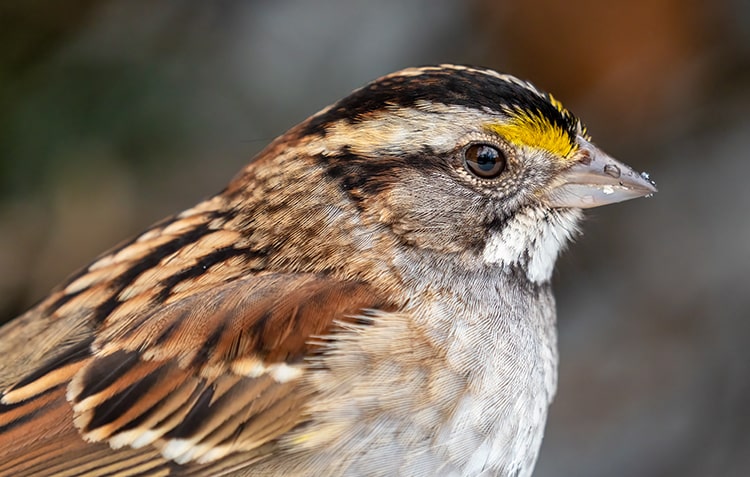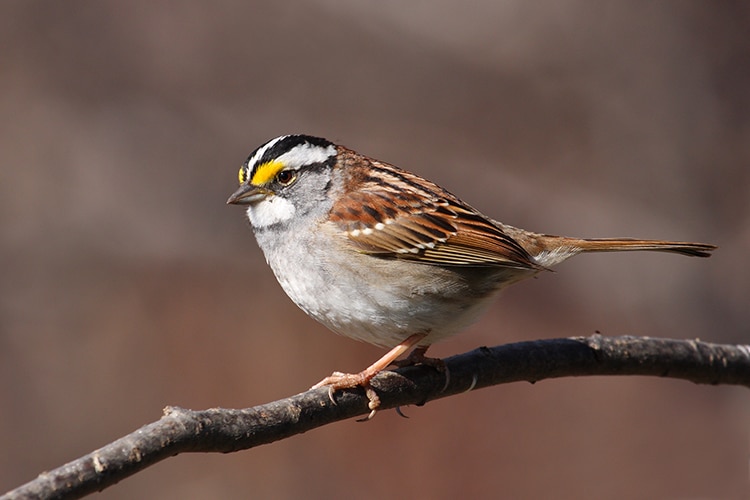
The white-throated sparrow, a unique creature. (Photo: Rhododendrites via Wikimedia Commons, CC BY-SA 4.0)
Sex in nature is hardly simple. While “biological sex” is often used in reductive and factually incorrect political parlance, the science of chromosomes is far from a simple dichotomy. In the natural world, some species change their sex as they age. Others such as the white-throated sparrow have a whopping four sexes or genotypes. As described in Current Biology, the species has evolved to have a surprising chromosomal anomaly which makes mating more complex.
The Zonotrichia albicollis, or the white-throated sparrow, has white and tan morphs, or subspecies. The white males are promiscuous while neglecting their paternal care, unlike tan males who are monogamous and do their due diligence to offspring. Females also trade off between investment in parental care and mating effort.
The white and tan striped birds typically mate with individuals of the opposite color. Within the white-striped birds, a gene mutation flipped a section of chromosome two creating a “supergene.” This new type of chromosome cannot exchange genetic material with its mate. As discovered by scientists in the 1960s, this means tan birds have two identical chromosomes, whereas white ones have one regular and one inverted. A white-tan pairing has a 50% chance of inheriting the inverted gene.
In the early 2000s, the married researchers Elaina Tuttle and Rusty Gonser discovered that the inverted gene was not a simple “flip.” Instead, the gene was more scrambled. They hypothesized that the gene is evidence that the species is evolving two new chromosomes, to make four total.
“These birds are an amazing system,” says Catherine Peichel, an evolutionary ecologist at the University of Berne, told Nature. “The process of sex-chromosome evolution tends to erase much of the evidence of how it happened, so being able to watch the process in action is a huge benefit.” Sadly, Elaina Tuttle passed in 2016, shortly after the publication of her incredible paper.
Her discoveries continue to fascinate us. “This bird acts like it has four sexes,” says Christopher Balakrishnan, an evolutionary biologist at East Carolina University in North Carolina, who worked with Tuttle and Gonser. “One individual can only mate with one-quarter of the population. There are very few sexual systems with more than two sexes.” This mating dance, however, is a lot of work. Balakrishnan notes, “That we never see systems with four sexes says that they’re evolutionarily unstable and one of these alleles will ultimately go extinct.”
Multi-sex species are not unique to sparrows. One microbe has seven sexes. What is sure is that nature’s sexes are diverse and complex. As the white-throated sparrow: “There’s a lot more information left in these birds,” Gonser says. “And I think Elaina would like that we’re trying to uncover their secrets.”
The white-throated sparrow, or Zonotrichia albicollis, has four genotypes or sexes, making mating a more complex dance.

The species has four sexes. (Photo: Cephas via Wikimedia Commons, CC BY-SA 3.0)
h/t: [IFL Science]
Related Articles:
Snowy Owl Makes a Surprise Appearance in Southern California Town
Incredible Aerial Photos Highlight Beauty of Great Flamingo Migrations
Awards Highlight Incredible Beauty and Variety of Australia’s Birds
Young Bar-Tailed Godwit Sets World Record for Longest Continuous Flight
